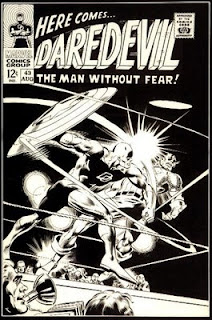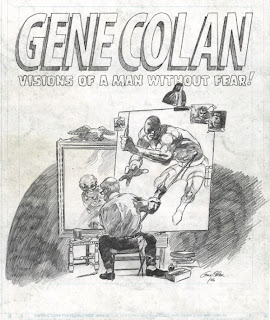 With the original cover for Iron Man and Submariner #1 staring at you from the wall of the Cartoon Gallery, just a foot or two away from the cover to Iron Man #1, and Captain Marvel #1 you come away with three distinct impressions: 1) Gene knew how to put big dynamic figures front and center - they're great covers; 2) Gene definitely wasn't great with knees; and 3) Marvel's production department looks like a bunch hacks given that the printed versions of two of the three covers are not the originals!
With the original cover for Iron Man and Submariner #1 staring at you from the wall of the Cartoon Gallery, just a foot or two away from the cover to Iron Man #1, and Captain Marvel #1 you come away with three distinct impressions: 1) Gene knew how to put big dynamic figures front and center - they're great covers; 2) Gene definitely wasn't great with knees; and 3) Marvel's production department looks like a bunch hacks given that the printed versions of two of the three covers are not the originals!
Gene himself is a true original, as his one man show at the San Francisco Cartoon Art Museum will attest. A gracious and talented gentleman, Gene was on hand to soak up the applause last thursday night from the 150 people or so who crammed into the museum to hear testimonials from Steve Englehart, Joe Rubenstein, Steve Leialoha and Stan Lee.
Curated by Glen David Gold, the author of Carter Beats the Devil, who deftly straddles that line between uberfan and actual functioning adult, Glen gave us original art lovers the chance to see some art that, I suspect, we will never see again given that it is all in the hands of private collectors. He also gave us the chance to fete Gene in person, a rare treat.
 The scans here are a sample from the catalog of the exhibition, which itself is a nice treat. Great commentary by Gene's peers and collaborators, including excellent reproductions of work that you’re not going to find anywhere else: The original cover to Daredevil #43, which Kirby ended up redoing so that it didn’t appear that Captain America was losing to DD in the ring. For those interested, there may still be more available from the Cartoon Art Museum itself.
The scans here are a sample from the catalog of the exhibition, which itself is a nice treat. Great commentary by Gene's peers and collaborators, including excellent reproductions of work that you’re not going to find anywhere else: The original cover to Daredevil #43, which Kirby ended up redoing so that it didn’t appear that Captain America was losing to DD in the ring. For those interested, there may still be more available from the Cartoon Art Museum itself.
Stan Lee didn't come himself, but did send along a video tribute, one that sounded and felt terribly heartfelt. However, it is difficult for me to listen to Stan say:
On a personal note - Gene colan is a gentleman. honorable, dependable and loyal. I always got a kick out of calling him Genial Gene or Gentleman Gene, but most important of all, I'm proud to call him my friend.Knowing that Stan is in good health, and wealthy enough as the perennial company man that he was, to be able to say these things, while Gene struggled with his glaucoma and no health insurance over the last decade. Once again, Marvel continues to ignore the aching backs of the men that the company was built upon, and it hurts to see.
 Given the Gene has no vision in one eye, and limited vision in another, the newer pencilled works here show remarkable clarity of composition and pencil technique. Gene's hand has lost none of its subtlety, and the new work doesn't suffer in comparison to the beautiful two page spreads from Doctor Strange and Tomb.
Given the Gene has no vision in one eye, and limited vision in another, the newer pencilled works here show remarkable clarity of composition and pencil technique. Gene's hand has lost none of its subtlety, and the new work doesn't suffer in comparison to the beautiful two page spreads from Doctor Strange and Tomb.
The best line of night: there are entire schools of Kirby or Steranko or Adams, and yet, there is no school of Colan. There is simply no one with the touch and ability that Gene has with a pencil, nor his idiosyncratic layouts and storytelling approach. In his tribute, Stan uses the word "inimitable". Gene truly define that word, from the ground up.
All the very best Gene, I'll probably never be able to afford a piece of your art for my collection, but I'll never stop trying!
In addendum: the cover for Captain Marvel #1 is completely hacked up, cutting out the Marvell figure and moving it up to change his position on the page. The Iron Man #1 cover has a side note: "after inks - raise up to get IM's head overlap title", which means that the printed cover of IM #1, which has pretty murky line work, is not the result of bad inking by Johnny Craig, but of pasted up stats of the original cover, with some of Colan's beautiful vingettes moved or removed. Craig's line work on the original is actually both bold and delicate and extremely lively.































